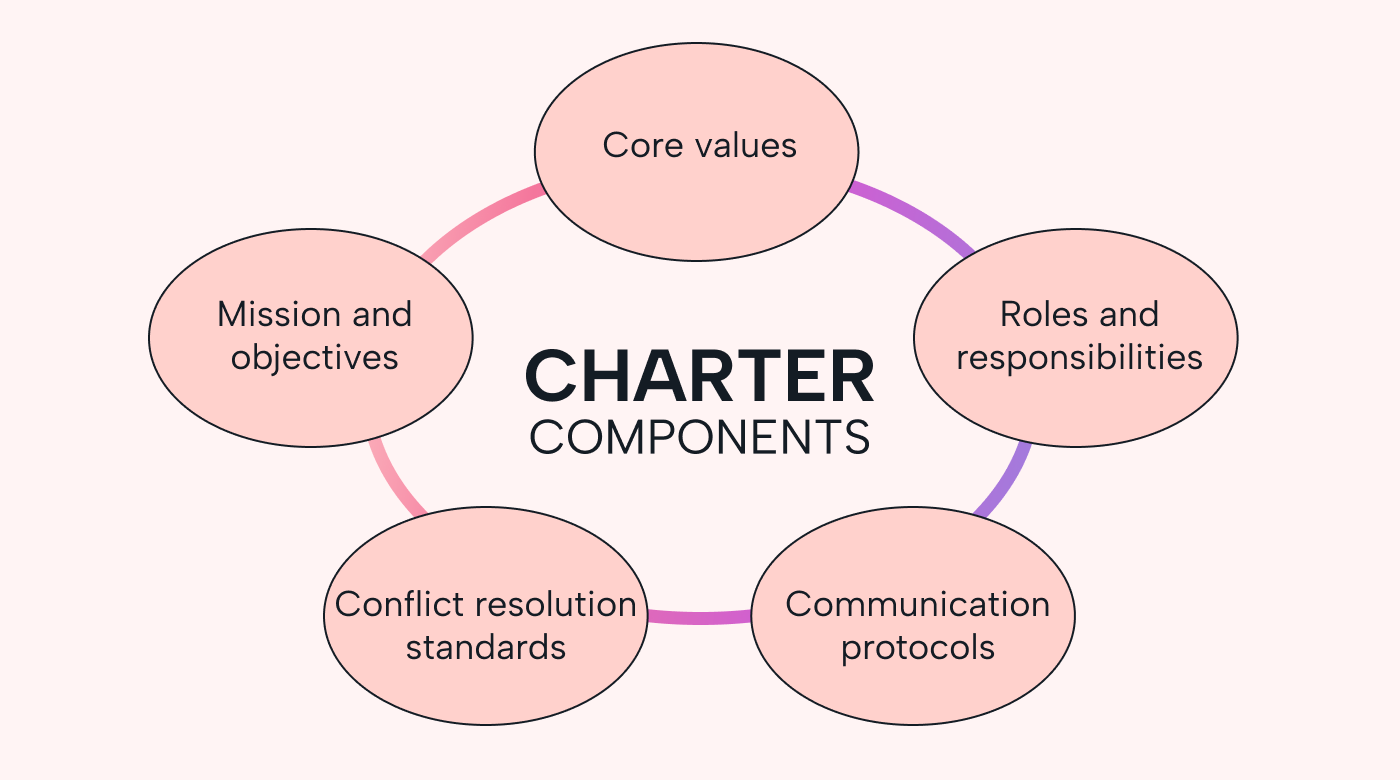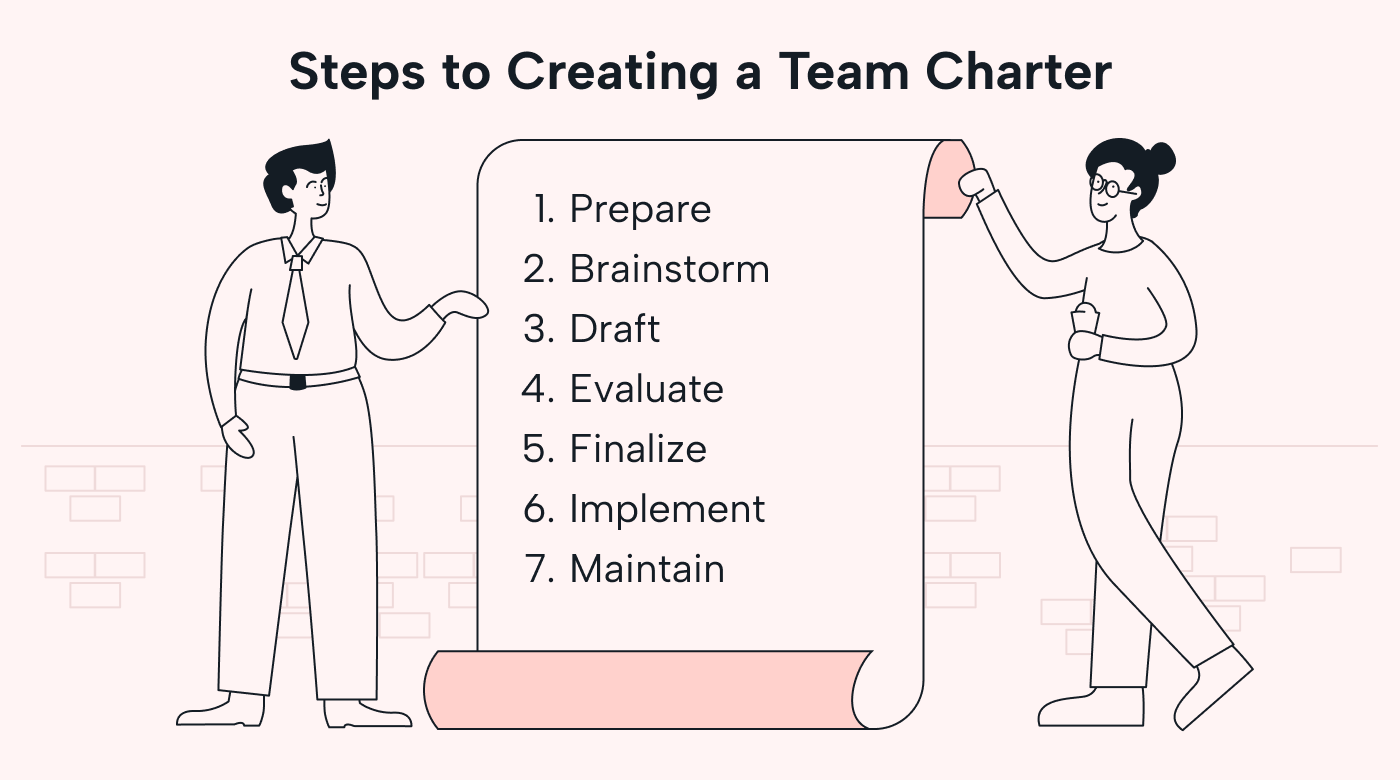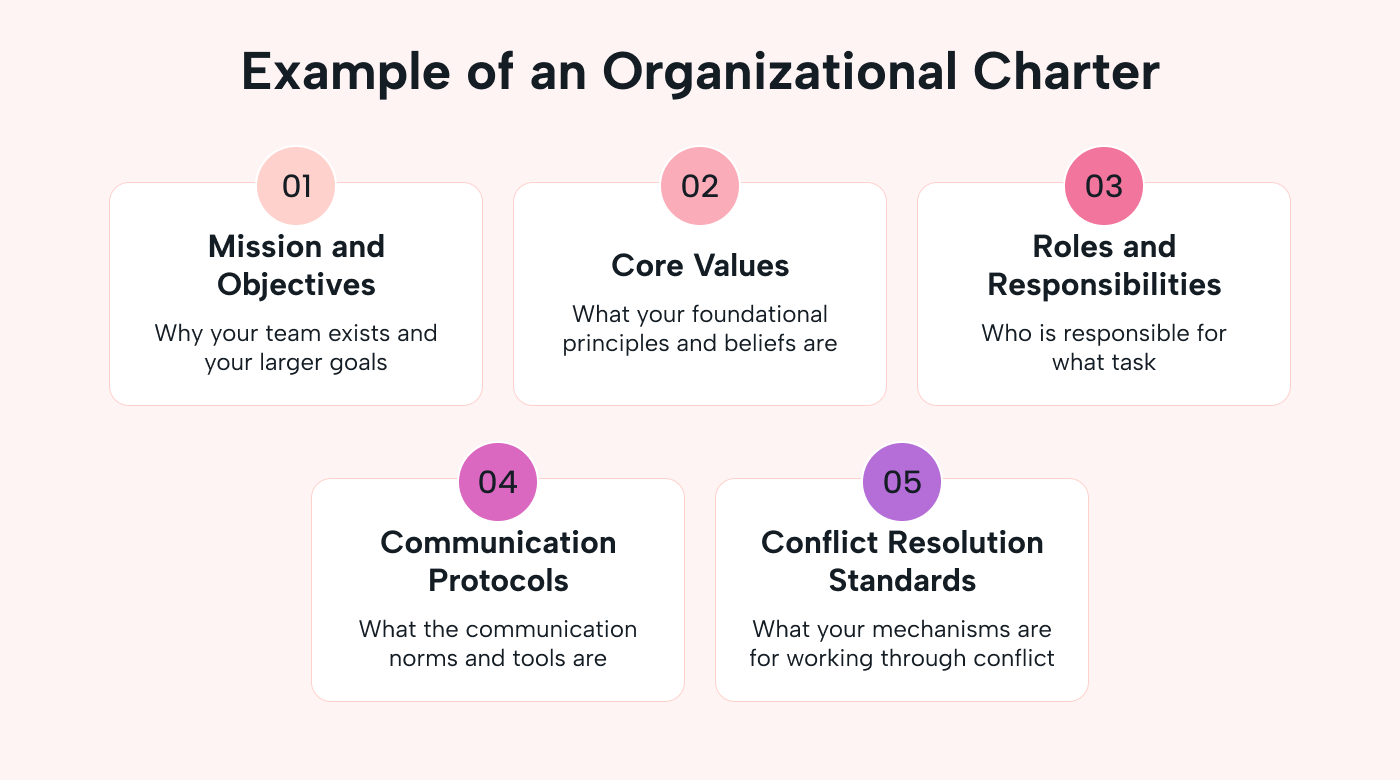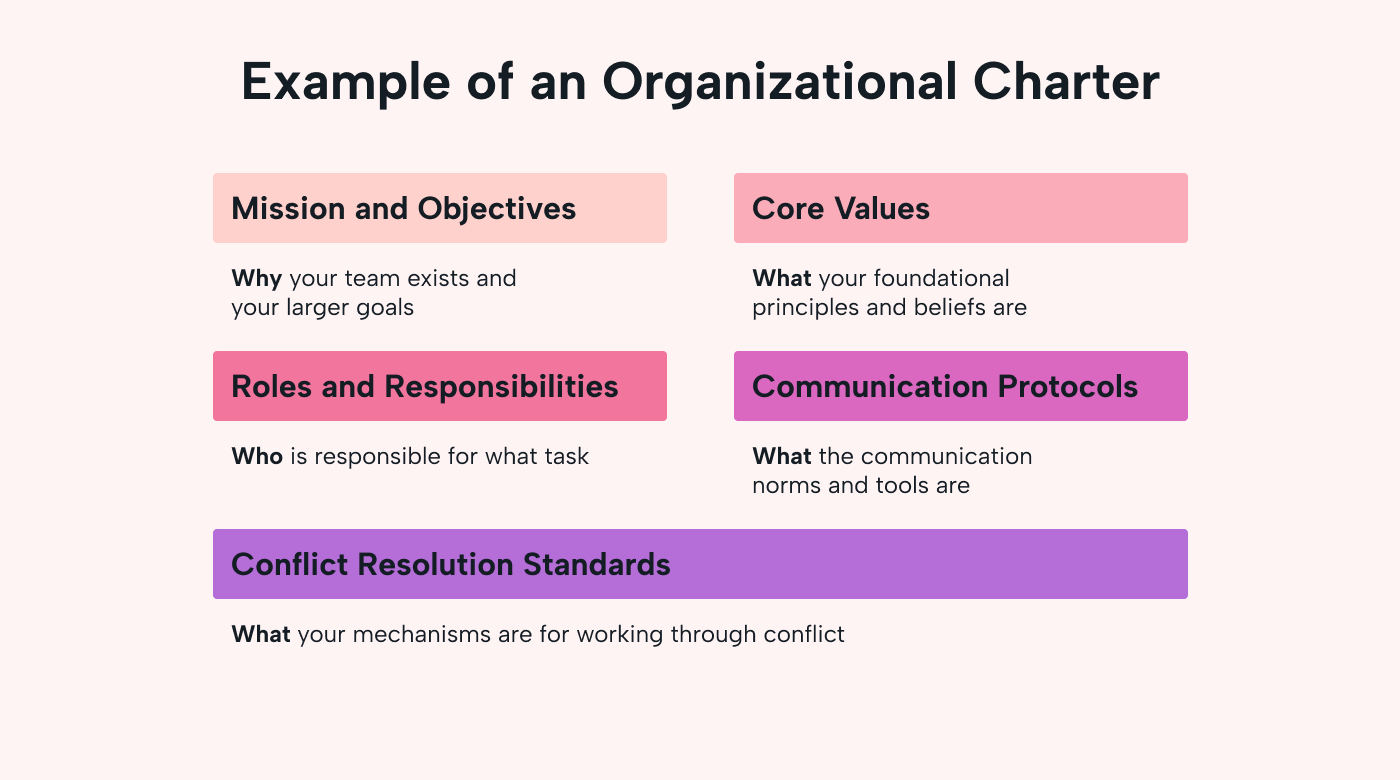Misalignment in a team can lead to big problems.
Conflicting goals, overlapping roles, and haphazard communication can drag your whole organization down.
That’s why it’s worth creating a team charter — a living document that says who you are and how you operate.
In this article, we’ll tell you how to build a team charter that works.
What is a team charter?
The importance of having a cohesive and well-aligned team can’t be overstated. Here’s where the power of the team charter comes in.
A team charter is a written agreement that serves as a foundational guide for teams. It’s a blueprint that outlines how the team operates, communicates, and achieves its objectives.
This tool offers teams both direction and clarity. In other words, it covers not just the destination but also how to get there.

A team charter strives to answer three fundamental questions:
1. Why does this team exist?
Beyond the tangible deliverables, this question dives into the very essence and purpose of the team’s existence.
Whether it’s to launch a new product, streamline internal processes, or tackle a specific challenge, the charter articulates the “why” behind the team.
2. What objectives does the team aim to achieve?
The charter also includes specific, actionable details. It lists what the team wants to accomplish.
These objectives might be:
- Specific goals
- Milestones
- Other targets the team strives for
This aspect of the charter acts as a yardstick for measuring the team’s success.
3. How will the team work together to complete these objectives?
The charter lays out the team roles and responsibilities, ensuring that every team member knows their part.
To keep operations running smoothly, it defines:
- Communication protocols
- Decision-making processes
- Conflict resolution strategies
Today’s working world needs team charters more than ever. Our companies span the globe, intersecting different cultures and languages. This means the modern workplace is full of cross-functional teams, remote setups, and project-based assignments.
All of these variables can lead to bottlenecks and misalignment.
Fortunately, a team charter can help you navigate these variables. It helps team members understand each other, their roles in the operation, and how to work collectively toward shared goals.
Why every team needs a team charter
Here are some reasons why every team, regardless of their size or industry, can benefit from a well-crafted team charter:
To align with organizational goals
A team charter helps ensure that projects and initiatives are consistently aligned with broader organizational aims.
Every company has a mission statement and some sort of vision, but it’s common for project teams to work in silos and diverge from these core objectives.
For example, 2023 Salesforce research shows that while organizations today use over 1,000 apps, many to help with communication and collaboration, the vast majority aren’t integrated into the business. This leads to disconnected departments, data silos, and slowed efforts.
To ensure that roles and responsibilities are clearly defined
Confusion regarding who’s responsible for what can lead to missed opportunities or duplicated work.
Picture a marketing campaign where both the graphic designer and copywriter assume the other is responsible for the final proofreading — and a costly error goes unnoticed as a result.
With a team charter, each member’s role and responsibility are crystal clear.
To allow for better conflict resolution
Conflict can be a source of growth if managed well.
A team charter proactively addresses potential areas of dispute by establishing procedures and norms for conflict resolution.
Susan Clews, Chief Executive for Acas, recently said of conflict: “...there is a critical time to intervene. This is before conflict reaches formal workplace procedures.”
That’s when conflict gets costly — through resignations and serious disruptions. Fortunately, however, an effective team charter helps keep problems from reaching that point by ensuring that teams start on the right foot.
To ensure consistency and accountability
A team charter sets clear expectations and standards. When every member is aware of these standards and the team commits to them, an environment where members hold themselves and each other accountable is the result.
The components of a team charter
Before we run through the steps of creating a team charter, let’s cover its main components.

Mission and objectives
A mission is a high-level view of the team’s purpose. It explains why the team exists and the larger goal it serves within the organization.
Objectives break a mission down into tangible, achievable targets.
Core values
Core team values reflect the principles and beliefs that guide the group’s behavior. They represent the team’s worldview or moral compass.
These values dictate how team members interact with each other, stakeholders, and the organization as a whole.
Roles and responsibilities
This component answers questions such as the following:
- Who is responsible for decision-making?
- Who oversees communication?
- Who is the point person for external stakeholders?
Outlining the different roles and responsibilities means the charter helps prevent overlap and reduce confusion.
Communication protocols
Without established team norms, communication can become chaotic. Important messages might be misinterpreted or go unseen entirely.
A team charter dictates which communication tools the team will use. It determines how often they’ll meet and what the agenda for those meetings will be.
Conflict resolution standards
This last component of a team charter outlines the procedure for handling disagreements.
Whether the solution to a disagreement is a democratic vote, external mediation, or something else entirely, having these mechanisms in place helps ensure that conflicts become opportunities for growth rather than sources of disruption.
How to create a team charter: A step-by-step guide
This guide will lead you through creating a robust team charter that’s tailored to your team’s needs.

Step 1: Lay the groundwork
The first step is the preparation stage. Start by addressing current challenges and team dynamics. Tap into your pain points and visualize the possible benefits of a team charter.
Keep those in mind as you begin to evaluate where you are and where you’re trying to go.
Step 2: Brainstorm as a team
The best ideas emerge collaboratively. So, kickstart the process by holding an inclusive brainstorming session.
Gather all team members and facilitate an open discussion that includes the following:
- Mission
- Vision
- Roles
- Challenges
This inclusive approach ensures every voice is heard and gives you the broad perspectives and insights you need for the next step: drafting.
Step 3: Draft each component
Armed with insights from the brainstorming session, begin drafting the charter.
Be as explicit as possible for each component. Consider the following:
Purpose and objectives
- Why does this team exist? What are its short-term goals and long-term goals?
Roles and responsibilities
- Who leads specific tasks? Who supports them? What are the expectations for each role?
Communication protocols
- How will the team communicate? Will there be weekly meetings? Which tools will the team use for day-to-day communication? What barriers to personal time will the team have to overcome?
Core values
- What are the values that power teamwork? Are transparency and open communication a priority? Or perhaps innovation and adaptability?
Conflict resolution procedures
- What steps will the team take to address disagreements? How will the team mediate? How will the team vocalize and resolve grievances?
Step 4: Gather feedback
Your charter shouldn’t exist in a vacuum. Share the preliminary draft with your team and any relevant stakeholders.
Gather inputs, concerns, and suggestions about the charter. Multiple rounds of feedback might be necessary, but the goal is to create a charter that resonates with everyone.
Step 5: Finalize the charter
After taking in the feedback, finish drafting your charter and put together your final version.
Decide on an appropriate format — perhaps a digital document or visual poster.
Finally, hold a sign-off session to symbolize each member’s commitment to the charter.
Step 6: Implement the charter
Integrate the charter into your daily operations. Reference it in meetings and use it as a guide for decision-making.

Additionally, embed it into the onboarding process so that all new hires are immediately aware of it. Viewing the charter will help them understand team dynamics and their role more clearly.
Step 7: Maintain and update the charter
Don’t let your charter grow dusty; it’s vital to revisit it periodically.
Schedule regular check-ins — quarterly or bi-annually — to reassess its relevance. Are all of its elements still aligned with the team’s reality? If not, then it’s time for an update.
Bonus: examples of organizational charters
It helps to have a visual. Here are a few examples of how these charters can look once you’re finished writing them.

Here’s another example showcasing a different style and structure:

Common myths about team charters
As with anything, misconceptions often get in the way of proper understanding and application. Here are some of the most persistent myths about team charters:
Myth 1: They’re too time-consuming
Many teams resist the idea of creating a team charter, thinking it’ll drain precious time that could be used for “actual work.”
But this couldn’t be further from the truth.
The time invested in crafting a charter can prevent future time losses due to misunderstandings, misalignments, and conflicts.
Myth 2: They’re too formal or bureaucratic
Charters are all about clarity.
A charter is not a restrictive document that drags the team down in red tape. Instead, it offers a clear framework for reaching common goals.
Myth 3: The team is functioning well enough without one
Maybe you believe the classic adage, “If it ain’t broke, don’t fix it.”
But even if your situation isn’t an emergency, a team charter is still a great tool for improving your operations.
A charter isn’t just useful for troubleshooting or realigning misdirected teams — it’s also a proactive tool for ensuring that high-performing teams continue to be so — even as they grow and take on new challenges.
And as new hires come aboard, you’ll be glad you have a team charter to align all your staff with.
Myth 4: It’ll just be another neglected document
The charter’s creation should be treated as a team-wide commitment. For a charter to remain relevant and useful, revisit it regularly and treat it as a living document.
A charter that’s treated as a cornerstone of a team’s operations stays alive and relevant. The responsibility of keeping it that way rests with the entire team.
4 tips for taking your charter to the next level
Here are some pro tips to help ensure your charter isn’t just effective but top-notch.
1. Make it visually engaging
A text-heavy charter might fail to captivate the team’s attention. Use infographics, charts, or icons to represent different components.

Visual representations not only make the charter more engaging but also aid in quicker comprehension and recall.
2. Embed real-life scenarios
One of the best ways to make a charter resonate is to ground it in real-world examples. That brings a practical dimension to it, making it more relatable.
When team members see the practical application of the principles outlined in the charter, they’ll be more likely to appreciate its significance and abide by its tenets.
3. Seek external feedback
An external perspective can provide invaluable insights into a team charter’s effectiveness. So, consider inviting a neutral party to review it. Their fresh eyes can spot gaps or areas for improvement that the internal members might have overlooked.
4. Celebrate charter milestones
A team charter isn’t a static document. As you hit objectives or navigate challenges using the charter’s guidance, celebrate these milestones.
Such celebrations can foster team spirit and reinforce the charter’s central role in the workplace.
Align your team with Motion
Now that you’re armed with knowledge of this important team document, it’s time to create one.
A team charter is worth its upfront time investment, as it helps to keep teams on track.
Once you have your team charter in place, you want to make sure you have the right tools for your team to thrive. That’s why we created our advanced calendar app.
Motion uses powerful AI software to integrate project management and task management, as well as automate your team members’ schedules. Try it for free today!





